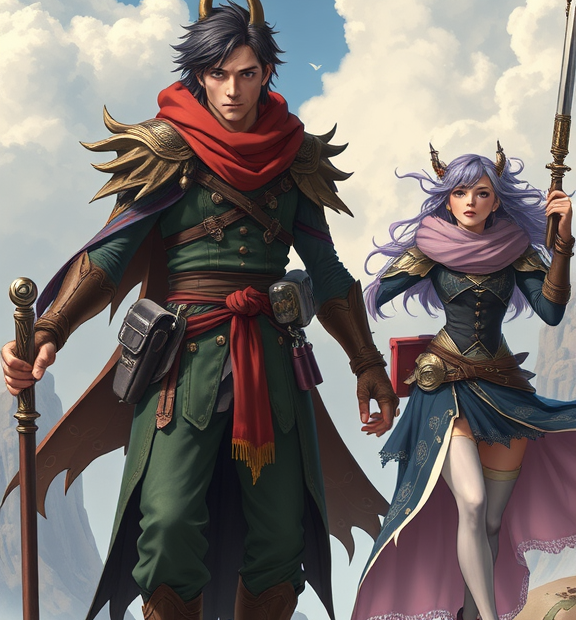Exploring the Depths of “Literally My Characters”: Understanding Their Journeys and Growth
Creating characters is one of the most fulfilling aspects of storytelling. When you hear someone say, “literally my characters,” it often reveals a deep connection between the writer and their creations. These characters aren’t just figments of imagination; they reflect complex human emotions and experiences. In this article, we’ll explore what it means to understand these journeys and how they grow throughout the narrative.
Character Development: A Journey of Transformation
As a writer, you might find that your characters undergo significant transformations. Character development is more than just changing a character’s appearance or status; it’s about evolving their personality and mindset through various challenges. Here are a few key elements to consider:
- Conflict: Every character faces obstacles that test their values and beliefs. This conflict drives their growth.
- Relationships: The way characters interact with others often shapes their journey. Friendships, rivalries, and romances can all transform a character.
- Motivation: Understanding what drives your characters can guide their decisions and actions, making their journey relatable.
For instance, imagine a character who starts as shy and reserved. Over time, through various experiences and interactions, they might become more confident and assertive. This transformation not only makes the character more engaging but also allows readers to connect with their journey.
The Emotional Arc
Every character should have an emotional arc that aligns with their journey. This emotional growth can take many forms, such as:
- Realization: Characters often reach a point where they understand their weaknesses and strengths.
- Acceptance: Accepting their situation helps characters move forward and make better decisions.
- Change: True growth happens when characters adapt and change their lifestyles or mindsets.
Consider a character who has struggled with self-doubt. Their journey might involve facing various setbacks, eventually leading them to a moment of realization where they understand their value. This makes their growth relatable and inspiring for the audience.
Creating Relatable Characters
When you think of your characters as literally part of your life, you end up creating highly relatable figures. To enhance this connection, focus on these aspects:
- Flaws: Perfect characters are less engaging. Flaws humanize them and make readers feel a connection.
- Goals: Understanding your character’s goals provides insight into their motivations and decisions.
- Backstories: A well-developed backstory adds depth, making characters more believable and layered.
For example, a character who is ambitious might have faced hardships in their early years, driving them to succeed. Their flaws and past experiences enrich their personality, making them feel real.
The Reader’s Connection
Love what I do? Be a hero and help me keep creating awesome content!
Support My Mission Now!Every donation fuels more great stuff – thank you, legend!
As you craft the journey of your characters, remember your readers are on this journey with you. Here’s how to keep them engaged:
- Consistency: Keeping your characters’ actions consistent with their personalities creates trust with your audience.
- Growth Through Adversity: Readers love to see characters confront and overcome challenges. This keeps them invested in the story.
- Emotional Moments: Use emotional moments to connect readers with your characters. These pivotal scenes bring out empathy and understanding.
When readers feel like they can relate to “literally my characters,” it transforms their reading experience. They’ll cheer for their victories and empathize with their struggles.
The Enduring Impact of Your Characters
Love what I do? Be a hero and help me keep creating awesome content!
Support My Mission Now!Every donation fuels more great stuff – thank you, legend!
The journey and growth of your characters don’t end with the final page. Characters that resonate with readers often linger in their minds long after they finish the story. They inspire discussions, create fandoms, and even become icons. As you write, think about how your character’s journey mirrors real-life experiences, allowing readers to find hope and inspiration in their tales.
Exploring the depths of your characters—including their journeys, emotions, and growth—creates a lasting bond between them and your audience. When you write with intentionality and awareness of these elements, your characters will truly become “literally my characters” for both you and your readers.
The Role of Character Development in Engaging Storytelling
Characters are the heart and soul of any story. When readers connect with a character, they become deeply engaged in the narrative. The magic lies in how characters develop throughout the story, transforming and evolving, which enhances the overall storytelling experience. This journey of character development can turn an ordinary tale into a captivating one. Understanding this can help you craft memorable and relatable characters that resonate with your audience.
The Importance of Relatable Characters
Love what I do? Be a hero and help me keep creating awesome content!
Support My Mission Now!Every donation fuels more great stuff – thank you, legend!
You want your readers to see themselves in your characters or to aspire to be like them. Creating relatable characters allows your audience to connect emotionally. Ask yourself:
- What does my character want?
- What challenges do they face?
- What makes them unique?
When you provide answers to these questions, you begin to flesh out characters that feel like real people. Readers are drawn to characters who feel genuine and whose struggles mirror their own, making them invested in the outcome of the story.
The Arc of Character Growth
Love what I do? Be a hero and help me keep creating awesome content!
Support My Mission Now!Every donation fuels more great stuff – thank you, legend!
Character growth is crucial to engaging storytelling. Characters should evolve over the course of the narrative, learning lessons that could lead to transformation. This growth can take various forms:
- Emotional Growth: Characters face their fears and learn to deal with their feelings.
- Moral Growth: Characters may confront ethical dilemmas that challenge their beliefs.
- Skill Growth: Characters acquire new skills or knowledge, enhancing their abilities.
By showcasing a character’s growth, you make them more dynamic and relatable. Readers invest their emotions in characters that show resilience and change, as it reflects the complexities of real life.
Creating Conflict for Development
To develop compelling characters, you need to introduce conflicts that test them. These challenges create opportunities for growth and engagement. The tension can be external or internal:
- External Conflicts: This includes struggles with other characters, nature, society, or fate. For example, a hero battling a villain creates high-stakes tension.
- Internal Conflicts: Characters can wrestle with their emotions, beliefs, or decisions. This type of conflict allows for deeper character exploration.
Effective storytelling weaves these conflicts throughout the narrative, giving characters the chance to confront their fears and desires, making them more relatable and engaging.
Supporting Characters and Their Role
Don’t overlook the importance of supporting characters in character development. They can enhance the main character’s journey by providing challenges, support, or a contrasting perspective. Supporting characters can:
- Act as mentors or guides.
- Provide comic relief to balance drama.
- Create obstacles that push the main character to grow.
Each character, big or small, contributes to your main character’s development, enriching the overall narrative.
Engaging Your Audience Through Backstory
A character’s backstory is vital for creating depth. It includes their past experiences, relationships, and motivations. By revealing snippets of their history, you draw readers into their world, making them more invested. Consider using techniques such as:
- Flashbacks that provide insight into pivotal moments.
- Dialogue where characters reveal personal histories.
- Internal thoughts that expose motivations and fears.
Effective use of backstory can illuminate a character’s actions and decisions in the present, enhancing audience engagement.
Dialogue as a Tool for Development
Dialogue reveals character traits, relationships, and growth. Through conversations, you can show how characters change over time. Consider how a character might speak differently at the beginning versus the end of the story. This change can indicate personal growth. Well-written dialogue not only offers insight into a character’s mind but also keeps the story lively and engaging.
Love what I do? Be a hero and help me keep creating awesome content!
Support My Mission Now!Every donation fuels more great stuff – thank you, legend!
In sum, the role of character development in storytelling cannot be understated. Engaging characters who grow and change captivate readers. By focusing on relatability, character arcs, conflict, supporting characters, backstory, and dialogue, you can create a narrative that resonates deeply with your audience. As you craft your story, remember: it’s literally your characters who will bring your plot to life.
Conclusion
Reflecting on the theme of "literally my characters," we see how essential their journeys are to our understanding of narrative depth. When you immerse yourself in the stories of your characters, you witness not just their struggles but their growth and transformation throughout the plot. Each character embodies unique experiences that resonate with readers, prompting emotional connections that elevate the storytelling experience. These journeys are vital because they allow you, as the audience, to explore themes of resilience, change, and even vulnerability.
Love what I do? Be a hero and help me keep creating awesome content!
Support My Mission Now!Every donation fuels more great stuff – thank you, legend!
Character development is more than just a detail in engaging storytelling; it is a powerful tool that draws readers in and makes them care about what happens next. Well-rounded characters spark curiosity and empathy, ensuring that your audience is invested in every twist and turn of the narrative. When characters face challenges and triumphs, their relatability connects us all, proving that these figurative personas can reflect real-life experiences and emotions.
In crafting your narratives, consider how much power lies in the arc of each character. Embrace their stories, and allow them to unfold vividly on the page, enhancing not only the narrative but the reader’s experience as well. Realizing that these characters are a part of you—"literally my characters"—can enrich your storytelling, making each journey worthwhile. As you write, remember the impact of character development and how it can transform ordinary plots into remarkable journeys filled with meaning and engagement. Engage your readers through these vibrant characters, and watch as their connections deepen with every page.

